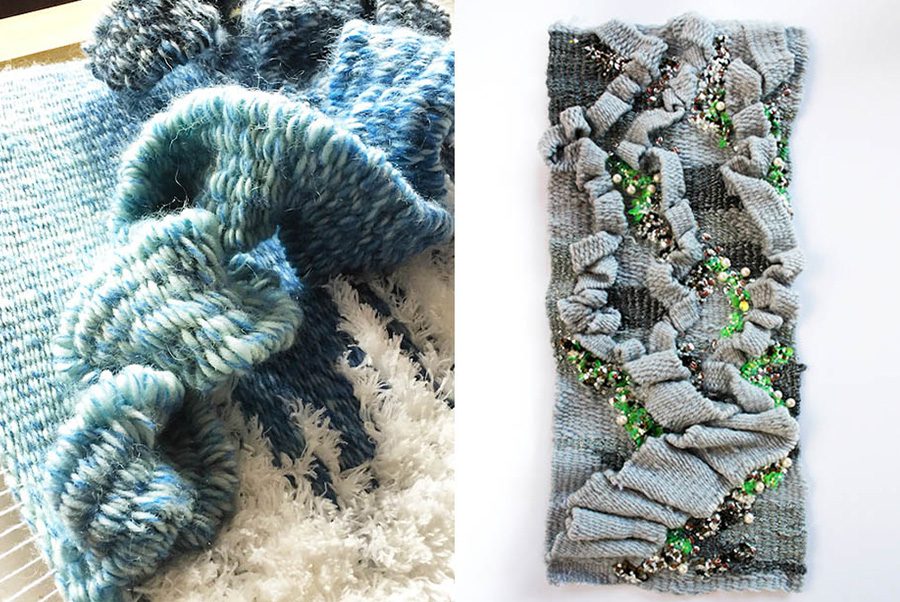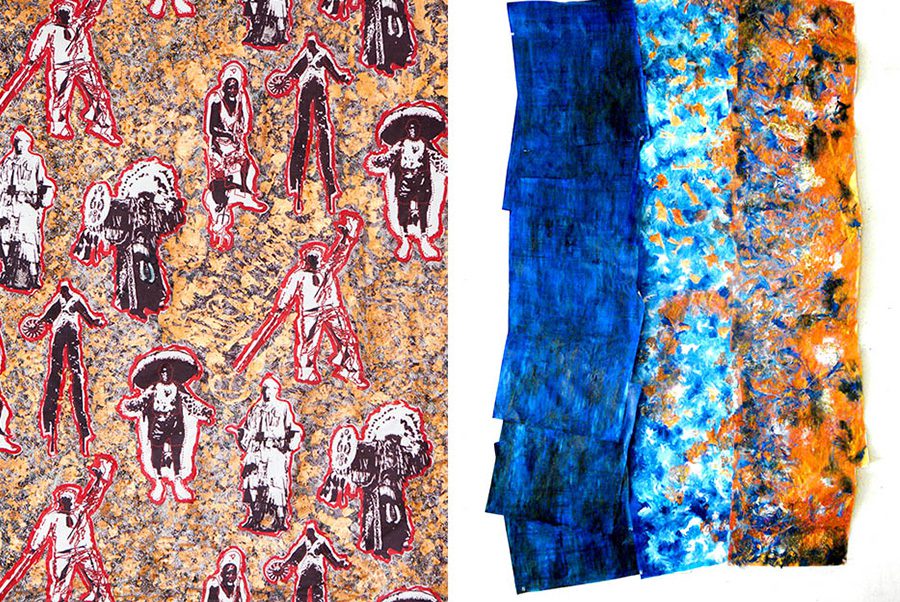

July 04, 2016
“I wanted to see if an architectural way of making could be developed that reflects the nature of Trinidad Carnival.”
In the aftermath of Carnival 2016 in T&T, you might assume that all the 20-something-year-olds would be hung over, recovering or asleep. And while they might have been, Latrelle Rostant wasn’t. The sculptor, architect and textile designer met me with a smile and a handshake, ready to talk about life in New York, carnival culture and, of course, making.
Latrelle attended Mucurapo Girls’ Roman Catholic School, then St. James Secondary, before migrating to the States. Her family moved around a lot but in the last two years of high school, she attended a Visual Arts programme and took up sculpting. While not fully clear on what she was going to do after the programme, she was encouraged by her Visual Arts teachers to show her work to a visiting representative from the Rhode Island School of Design. They invited her to apply to the prestigious school… she did and she got in.
You started with sculpture … How did you transition to Textile Design?
LATRELLE: Sculpture just wasn’t for me. I felt that the program was a little ‘too free’ for me. I understood the opportunity that going to RISD allowed me and I wanted to take advantage of it.
And the Textile Design process was different?
LATRELLE: Yes! It was very new, so I really had to spend time learning the craft… that slowed me down to think about what I was doing.
Making any sort of textile takes a lot of time: so, if you’re weaving, for example, it takes time to just to set up. Before you even get to your work, you have to wind the warp, and then dress your loom… the process of making struck a chord with me. It was something I really enjoyed.
What was influencing the style of your weaving at that time?
LATRELLE: What really got me going was my senior thesis. I created woven pieces that were based on hip hop culture and New York… I wove break-dancers and crowds of people using this French textile style called Toile de Jouy.
‘Toile de Jouy’?
LATRELLE: Toile de Jouy was a popular style of printed fabric that depicted scenes of 18th century life . So, I was doing stuff that was in that style but in an American, hip hop context.
So, after that project, what happened next?
LATRELLE: Well I graduated next, and then it took me a while to sort out what I wanted to do.
I started working for a home textile company creating towels and bedding but I was not in love with that at all. Then that year in 2005 I came home to Trinidad for the first time since I left as a child. I played mas and fell in love with Carnival…
When I got back to New York, I started to think that I would actually like to get involved in Carnival, but I was living in the US and getting into Carnival was not something that I could just pick up and do. So in 2009 I decided to go to Grad School for Architecture.
Considering that you finished your BA in Textile, what triggered the switch to Architecture?
LATRELLE: I think I was looking for a way to incorporate all aspects of my art education. I started to think about the similarities between textile and architecture and how both deal with defining a space that the body occupied. Architecture just seem like the right next step… it was going to force me to learn how to make in a new way, at a different scale.
How did the experience of studying architecture influence your creative thinking?
LATRELLE: While studying architecture, I was surrounded by different people who helped form who I am now: Industrial Designers, Fine Artists, Ceramicists… But what they all had in common was a rigorous work ethic and high standards for creating their craft.
I was constantly thinking about what I was making, getting feedback… It makes you think: Why am I making it this way? What is influencing my decisions? How does this make sense to me?
I love architecture but, by the end, I knew that what you did in school is not always what you get to do after graduation and I did not want to pursue it as a profession.
Did the trip back home also influence your graduate experience?
LATRELLE: Yes! My trips back home always left me wanting to learn more about Carnival. Its history and the various traditional characters that are a part of it. When it came time to do my thesis I based it on Trinidad:
Trinidad Carnival and traditional Carnival characters like the blue devil, moko jumbie, and the fancy sailor.
I wanted to see if an architectural way of making could be developed that reflects the nature of Trinidad Carnival. I started by looking at the different scales of the masquerader and how they interacted with spectators, how they view and interact with each other and the spaces that it defined.
After I graduated with my Masters in Architecture, I went back to textile design feeling the need to find ways to incorporate architecture and textile and my Carnival experience back home.
In my research for my thesis I learned a bit about wire bending in Trinidad. So I thought, what if I incorporated that into my weavings?
I started doing three-dimensional woven surfaces: I would combine wire into the woven pieces to give the woven surface structure .This would allow the woven parts to rise, fold and bend into the work, I would manipulate the piece giving it a three dimensional surface, then I would add beading and sequins. This process allowed me to create a woven interpretation of Trinidad carnival costumes.
Why did incorporating Trini culture into your work become so important?
LATRELLE: I left so young… and I have these vague memories of Trinidad. Carnival allowed me an opportunity to belong, to be apart of something culturally significant to being Trinidadian.
I am constantly aware that I am too Trinidadian to be fully American but at the same time I am too American to be Trinidadian. Carnival gave me a space to immerse myself in my cultural identity.
You said that you recall bits and pieces of Trinidad as a child… Are those memories of things?
LATRELLE: It’s more about a freedom that I had: being outside and visiting family in Arima and Tortuga. Coming back I can recall memories that seem familiar but just out of reach. Kinda like this new mas but… I don’t know. Here, I see the pretty mas and the feather-work and I can appreciate it for what it is — beautiful. But I personally can’t play that. I’m like, noooooo!
What is it about the pretty mas and feathers exactly that bothers you?
LATRELLE: It does not bother me. People like it that’s why its popular. I’m just perplexed. They say: this is our theme and the sections are supposed to represent this. To me words mean things, if you’re going to say it represents something then I want to see that in what the presentations look like!
I was having a discussion with someone about where mas is going. You know, they used to design very elaborate costumes, but then Carnival sort of ‘evolved’ when they started dressing down the costumes so that they weren’t so overwhelming to masquerader, or so literal. It then just got less and less literal, to the point of beading and feathers.
So you have to ask yourself, where are we really going? At some point, we have to generate the mas of the future, mas that people want to play as well, but mas that tells a story. Something that will make Trinidadians say, this is an important part of my culture. And you want to do it in a way that would get people to stop watching it at home and come out and participate because it’s a presentation. It’s a show!
So, I’m intrigued and I would like to be involved in that discussion because, as Trinidadians we need to start making a stand and saying, “This is what the of future Trinidad mas is…”
If we don’t, who will?
It should show our identity then, show who we are…
LATRELLE: Yes! It’s very important. You can’t let other people decide what our culture is.
We have in our history things that we can pull from to really make something that can be true to who we are as a people. Sailor mas is a perfect example, we as a people have the ability to take something and make it our own by giving it new meaning.
Tell us a bit about your recent work and influences
LATRELLE: I did a commission for a sound studio… they had these extra large pieces of industrial felt that they wanted me to use, so I had to take the felt and manipulate it, like I manipulate my weaving. On top of manipulating the felt, I also wove long narrow rectangular pieces using the same technique as I did for my woven work . I then attached the weaving onto it to give it more surface texture, and applied beads.
My process is so connected to using my hand to make and manipulate the materials that I use.
There’s a book I read called, “The Hand: How Its Use Shapes the Brain, Language and Human Culture” By Frank R. Wilson. It validated the intuitive nature I have in regards to how I work and made me more aware of how I use my hands with my work.
The hand is the fiscal manifestation of the brain.
In today’s world, when you make things with a computer or whatever, you’re not really making… If you turn on the computer and you know Photoshop and you know Illustrator, it doesn’t mean that you really know what you’re designing. When you’re clicking away on the computer, you may visually see and understand what you’re doing but your mind isn’t really thinking about how you’re making it. You’re unable to catch yourself when you do something wrong.
When you use your hand to make or sketch something, your brain is directly connected into the process of what you’re doing. You end up constantly thinking about what you’re doing and how to do it better, thinking through ideas thoroughly to make something truly special!
Making with your hands just makes sense.
When that drive is in you, you process the world at a different pace; you see things differently; you understand yourself in the spaces you occupy differently; and you never really want to accept things as they are.
When you’re a maker, you’re constantly observing the world and, even though you’re here in this space and you’re present, there’s always something at the back of your mind thinking and processing what you are seeing.
When you make, you don’t just make once. You are constantly making! For me, it’s in my chemistry!
Really enjoyed this chat Latrelle.
Thanks so much for taking the time!



INTERVIEWER: TANYA MARIE